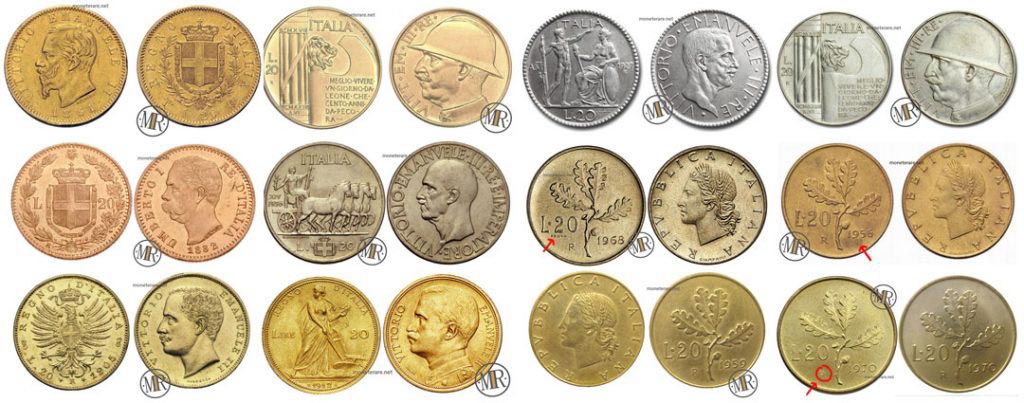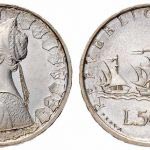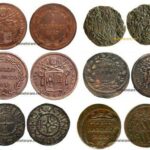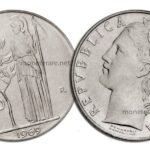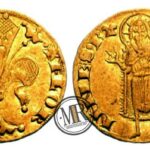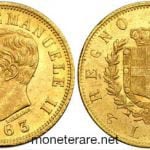The sesterce is perhaps one of the most well-known coins among all types minted in ancient Rome. Few people know about the dupondius or the quinarius, but almost everyone has heard of sesterces, even if only from the famous Roman jest:
“Caesar, the people are asking for sesterces!”
“No, no, tell them I’m moving forward!”.
In this page, we’ll talk about Roman coins “Sesterces” and list, as usual, their characteristics, history, curiosities, and, of course, the value these rare ancient coins can have. Happy reading.
Introduction to the Roman Sesterce
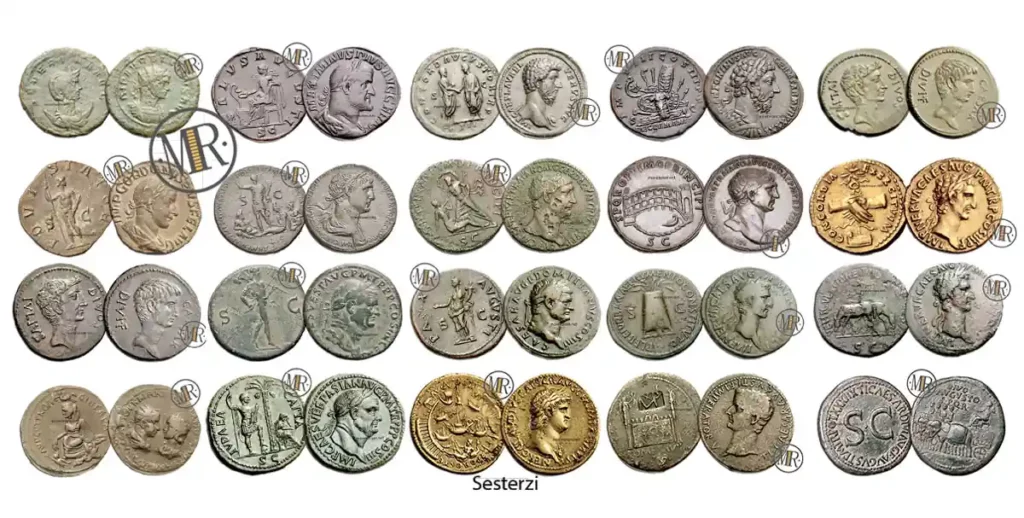
Around 211 BC, as we mentioned in our article on Roman coins, the denarius and its fractions were introduced. These included:
- the quinarius (½ denarius)
- the sesterce (¼ denarius).
Characteristics of the Roman Sesterce
The Sesterce, like the Denarius and the Quinarius, was initially a silver coin, and its name is derived from its relation to the most famous Roman coin: the as.
It weighs about one gram and has a diameter ranging from 12 to 17 millimeters.
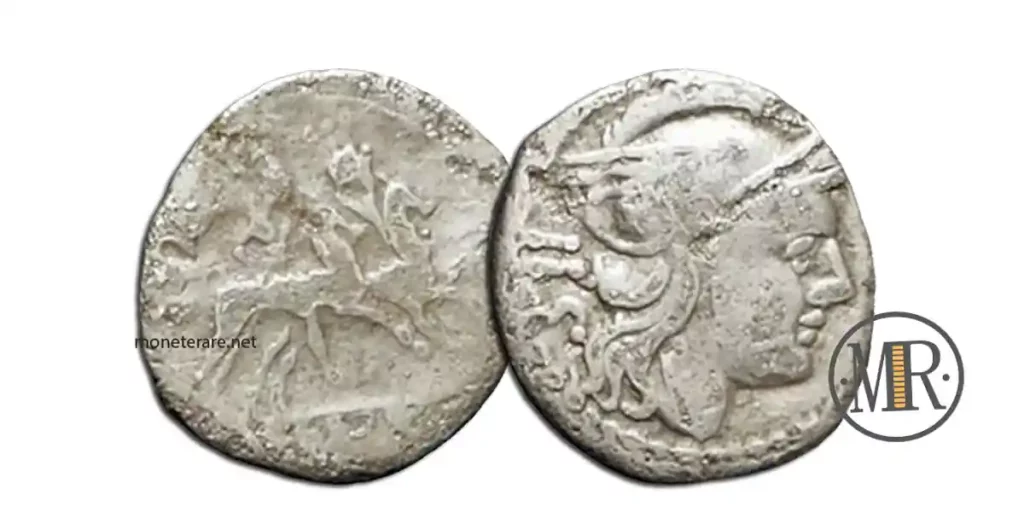
The Sesterce was worth two and a half asses. The name Sesterce derives from the Latin “semis-tertius,” meaning “half of the third [as].” The abbreviation HS also originates from how it was represented. Two adjacent “I”s represented two asses, and the “S” stood for “semis,” or “half [of the third as].”
In archaic times, numbers were represented by letters crossed by a horizontal line, and the original symbol was IIS, which later simplified to HS.
History of the Roman Sesterce
Despite its introduction around 211 BC, the Sesterce was minted sporadically during the Roman Republic, and it wasn’t until Augustus’ monetary reform around 23 BC that it became widely circulated.
The reform also led to changes in the material and format of the Sesterce.
It became a large-format coin and was no longer minted in silver but in orichalcum. Do you know what orichalcum is?
Orichalcum is an alloy very similar to brass, composed of a high percentage of copper (90%) and some zinc (10%). It was also used to mint the dupondius (worth 2 asses). As mentioned, the dimensions of the Sesterce also changed, with a diameter of 32-34 millimeters, a thickness of 4 millimeters, and a weight of 25-28 grams!
The last Sesterces were minted up until the late 3rd century AD. However, due to growing inflation, the double Sesterce had already been introduced, reduced in size and quality.
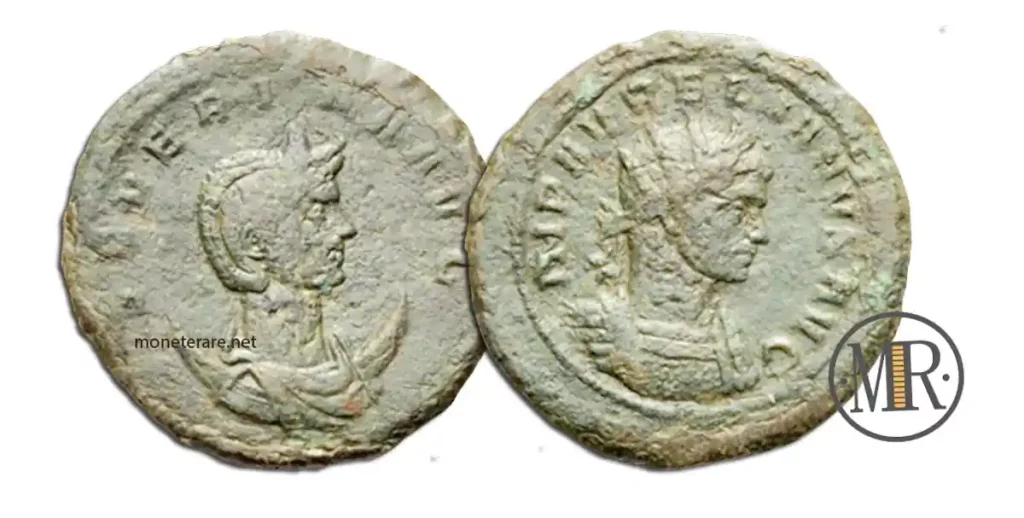
The Value of the Roman Sesterce
Initially, the Sesterce had a value of 2 and a half asses.
Around 142 BC, following changes to the weight of the as, the value of the denarius was adjusted from 10 to 16 asses, and the sesterce assumed a value of 4 asses, remaining equivalent to ¼ of a denarius.
As we know, the history of Roman coinage is marked by monetary reforms, which over the centuries led to changes in the types of coins in circulation.
How and Where to Buy a Roman Sesterce
If you’re interested in purchasing a Sesterce to add to your coin collection, we highly recommend visiting this portal, where every week (in the dedicated “ancient Roman coins” section), hundreds of items are available for sale.
The Price of the Roman Sesterce
The price of Sesterces varies greatly depending on the condition of the coin. Indeed, Roman coins like Sesterces are rare coins to find, especially in excellent condition, and in such cases, they can fetch very high prices.
Depending on their condition and rarity, more affordable Sesterces can also be found, accessible even to those starting a coin collection.
- An anonymous silver Sesterce from the Roman Republic, for instance, can be found for as low as €30 on the portal (click here) we use to purchase coins.
Julius Caesar Sesterce
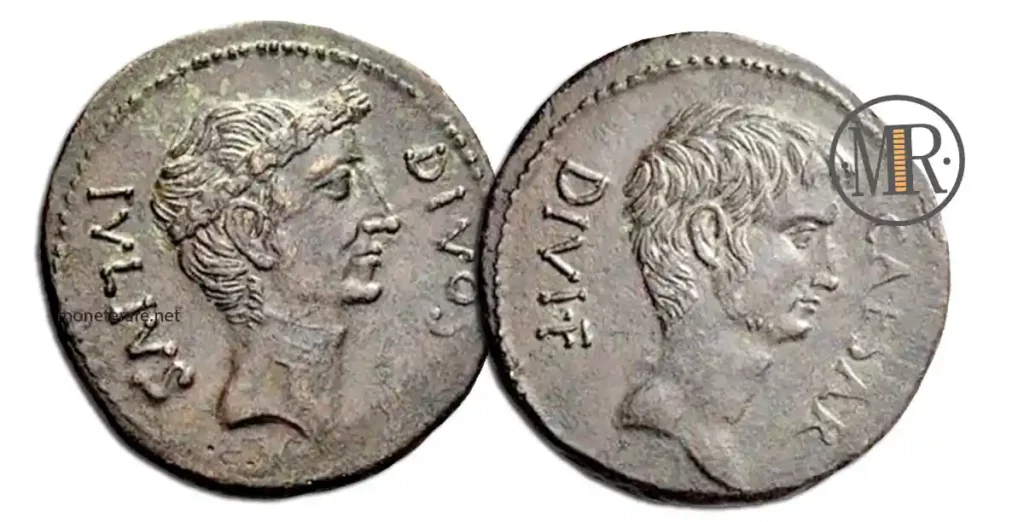
Description
The Sesterce minted during the period when Julius Caesar dominated Roman politics is a small bronze coin weighing about 19-22 grams with a diameter of approximately 30 millimeters.
On the obverse of this ancient coin, the profile of Octavian is featured, surrounded by the inscriptions “CAESAR” and “DIVI·F,” while on the reverse, the profile depicted is that of Julius Caesar, crowned with a laurel wreath, and the inscription “DIVOS IVLIVS.”
In another version of the Julius Caesar Sesterce, the reverse features the inscription “DIVOS IVLIVS” in the center, surrounded by a laurel wreath.
History and Curiosities
Julius Caesar is considered the first of the 12 “Caesars.”
Although he assumed the role of dictator and was proclaimed imperator by the legions, the Roman Empire was founded by Caesar’s adopted son, Octavian Augustus, who transformed the title of imperator into an equivalent of a prince and made it hereditary.
Value of the Julius Caesar Roman Sesterce
- In good condition, these Julius Caesar coins can fetch very high prices on specialized auction sites, exceeding €10,000.
Augustus Sesterce
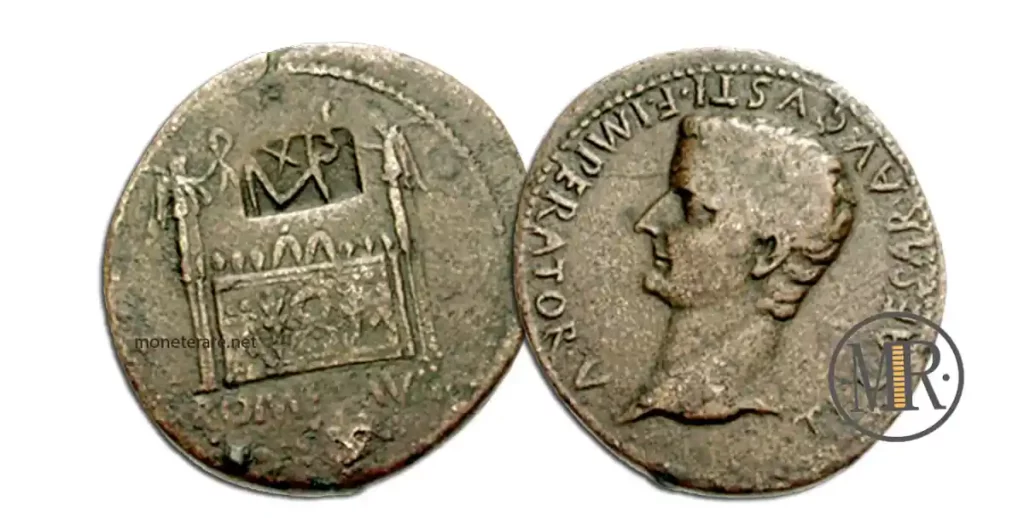
Description
The Sesterces minted by Augustus, following his monetary reform, were minted in orichalcum and weighed approximately 27.28 grams, with a diameter ranging from 29 to 36 millimeters.
On two orichalcum Sesterces of Augustus, the obverse features the profile of Tiberius (his successor), facing right on the Sesterce celebrating new campaigns in Germany, and facing left on the Sesterces commemorating the final victory in Illyricum.
Many Sesterces feature the effigy of Octavian Augustus, starting with that of Julius Caesar, as well as those of many of his successors who dedicated one side of their coins to him.
On a stunning Tiberius Sesterce, auctioned for €1,900 and classified as R, the obverse depicts a quadriga of elephants carrying Augustus in celebration.
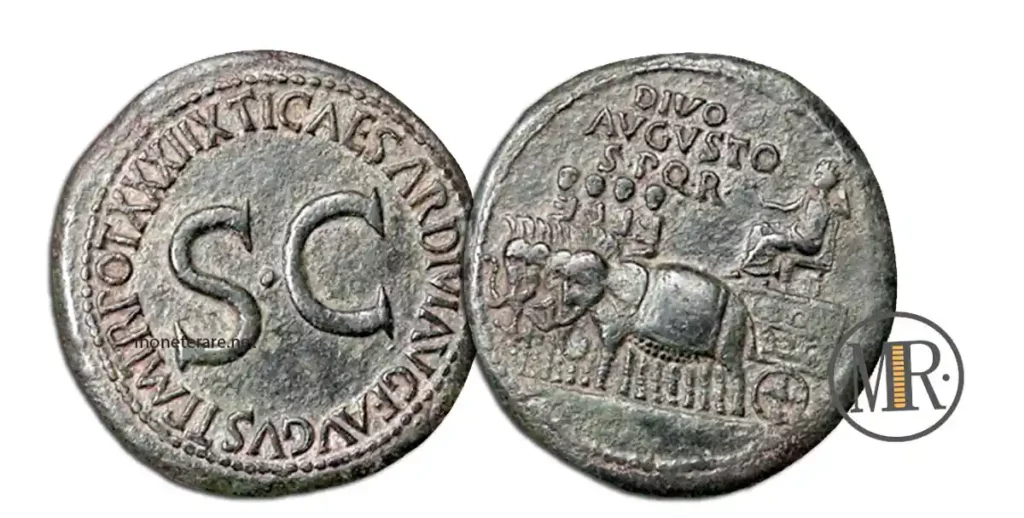
History and Curiosities
With his monetary reform, Augustus replaced the Sesterce, which had previously been a small silver coin weighing about one gram and easy to lose, with orichalcum Sesterces weighing around 27 grams and about 30 millimeters in diameter, making them excellent tools for propaganda.
Value of the Roman Sesterce of Augustus
- In an auction, an example of an Augustus Sesterce, graded between MB and BB, depicting Augustus with a laurel branch seated on a chariot drawn by four elephants, sold for €150.
Nero Sesterce
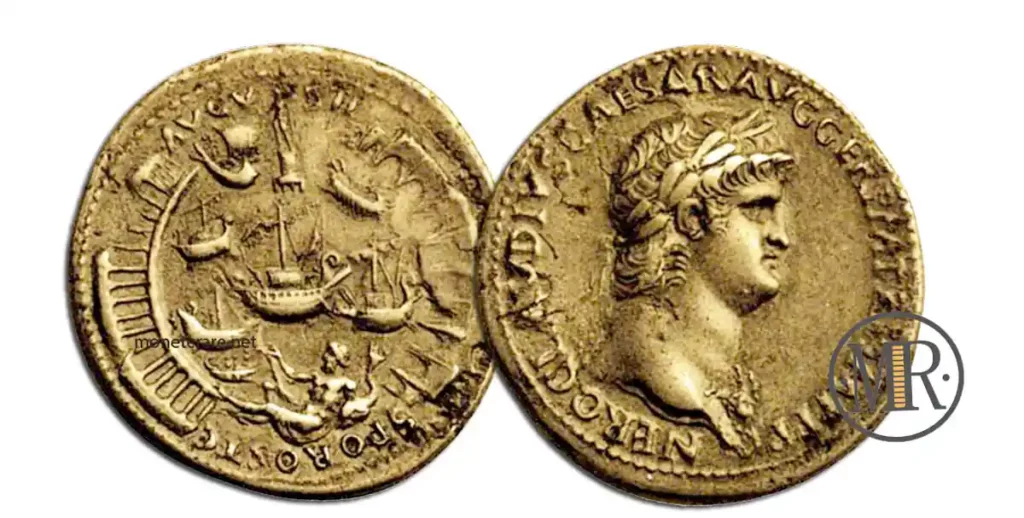
Description
On the obverse of all Nero Sesterces, the bust of the Emperor is depicted, while the reverse design often varies.
At least nine main types are known, featuring designs such as the Winged Victory, Helmeted Rome in armor, the Temple of Janus, a Triumphal Arch, Ceres and Annona, and more.
One of the most rare, sought-after, and beautiful coins is the Nero Sesterce depicting the Port of Ostia on the reverse. The number of ships represented in the port varies from 7 to 11, along with the lighthouse featuring the statue of Neptune and the figure of the Tiber River below.
History and Curiosities
Portus was the name the Romans used for the urban settlement developed at the mouth of the Tiber north of Ostia by Emperor Claudius and completed under Nero. The most sought-after Sesterce of Nero was minted to commemorate the opening of the Port of Ostia.
Nero was the last Emperor of the Julio-Claudian dynasty. After his reign, years of civil war followed, eventually leading to the rise of Emperor Vespasian.
Value of the Nero Sesterce
The value of Nero Sesterces can vary greatly depending on their condition and rarity.
- The Nero Sesterce with the Port of Ostia can fetch very high prices. One was sold at auction for over €7,000.
- However, auctions have also seen the sale of a Nero Sesterce with seated Ceres, in BB condition, for €450.
If you own rare coins like these (or even other rarer coins), you can have fun and make money by auctioning them online. We always use this partner site to buy and sell coins at auction. It’s the largest online coin auction platform, and we highly recommend it. Auctioning coins, whether selling or buying, is easy and exciting
Vespasian Sesterce
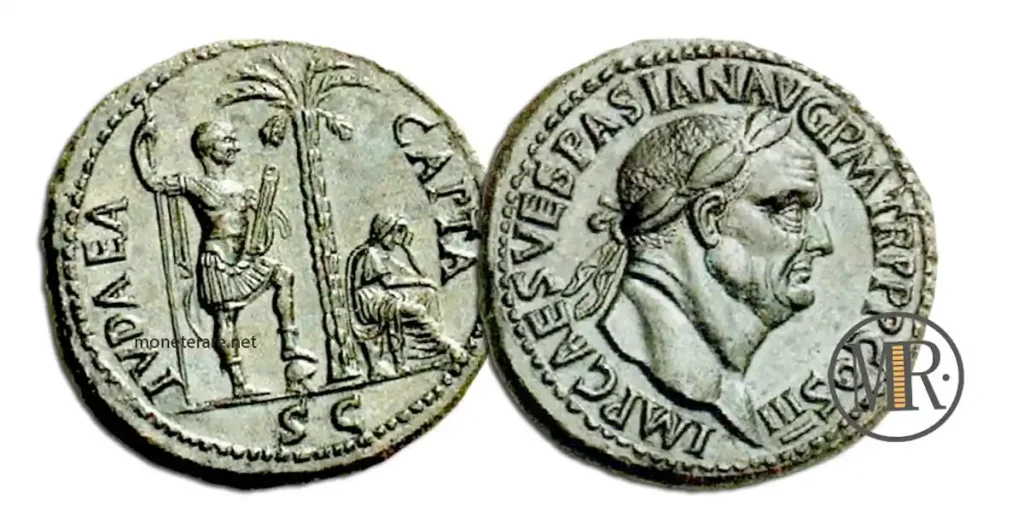
Description
The Vespasian Sesterces feature on the obverse the profile of the first Emperor of the Flavian dynasty: Titus Flavius Vespasianus.
The reverse designs are varied. Coins were one of the main tools for propaganda, and the reverse often depicted victories achieved by the Emperors.
For instance, to commemorate the victory in the campaign against the Jews, Sesterces were minted featuring on the reverse a palm tree flanked by a mourning Jewess and a prisoner with bound hands.
Encircling the design is the inscription “IVDEA CAPTA.”
Another version features the inscription “PAX AVGVSTI” on the reverse.
Classified as a rare coin is the Vespasian Sesterce with Mars holding a spear and trophy on the reverse.
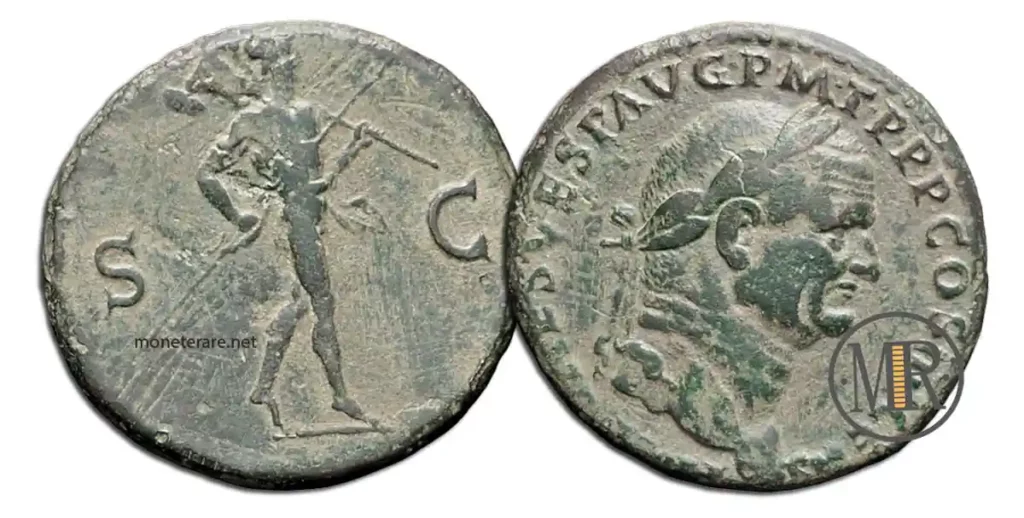
History and Curiosities
Vespasian was the first Emperor of the Flavian dynasty, rising to power after the civil war and being acclaimed by the legions of Egypt, the Danube, Judea, and Syria.
The Sesterce “IVDAEA CAPTA” celebrates the victory that opened the doors of the Empire to him.
Value of the Vespasian Sesterce
- A “IVDAEA CAPTA” Sesterce, initially valued at $2,500, was sold at auction in 2011 for $100,000!
- A Vespasian Sesterce featuring Peace seated with an olive branch and cornucopia was auctioned on October 21, 2018, for €300.
Domitian Sesterce
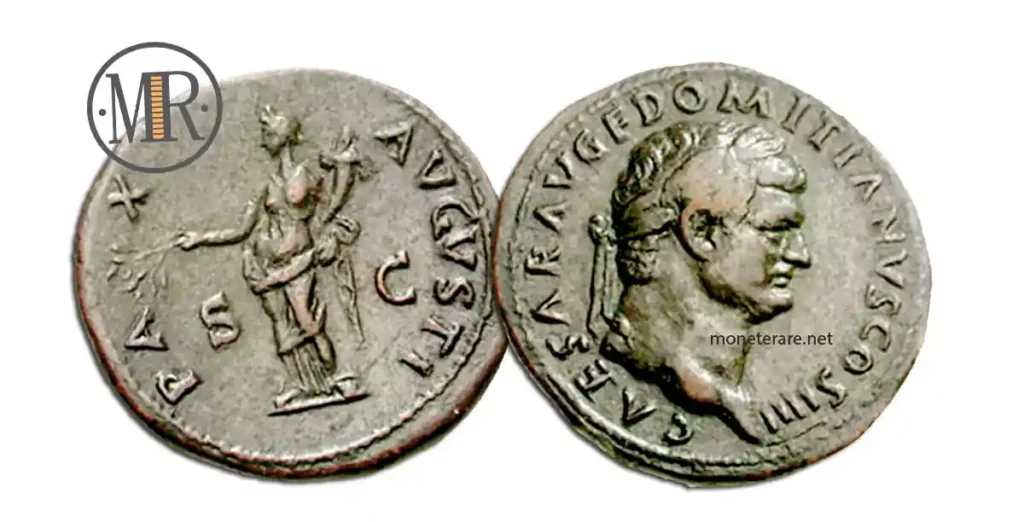
Description
On the obverse of these Sesterces marked “PAX AVGVSTI,” the bust of Domitian faces right, while on the reverse, Peace is depicted standing, facing left, holding a cornucopia under her arm and an olive branch in hand.
History and Curiosities
Domitian was the last of the Flavians to become Emperor, assassinated in 96 AD following a conspiracy. He was succeeded by Nerva, the first of the “Adoptive Emperors.”
Value of the Domitian Sesterce
- The Domitian Sesterce shown in the photo is classified as a rare coin (R3) and was sold in September 2004 on coin auction platforms like this one for $1,450!
Nerva Sesterce
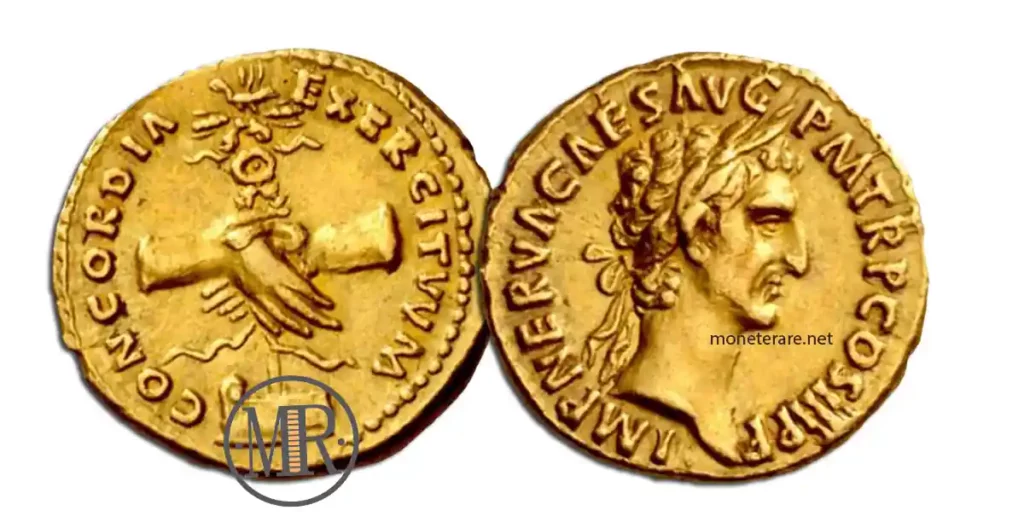
Description
On the obverse of all Nerva Sesterces, as usual, appears the bust of the Emperor.
There are various reverse designs. One type, minted to commemorate the Jewish tax reform, features a palm tree on the reverse.
Another Sesterce depicts on the reverse an ancient container, the modius, filled with six ears of grain and the inscription “PLEBEI VRBANAE FRVMENTO CONSTITVTO.”
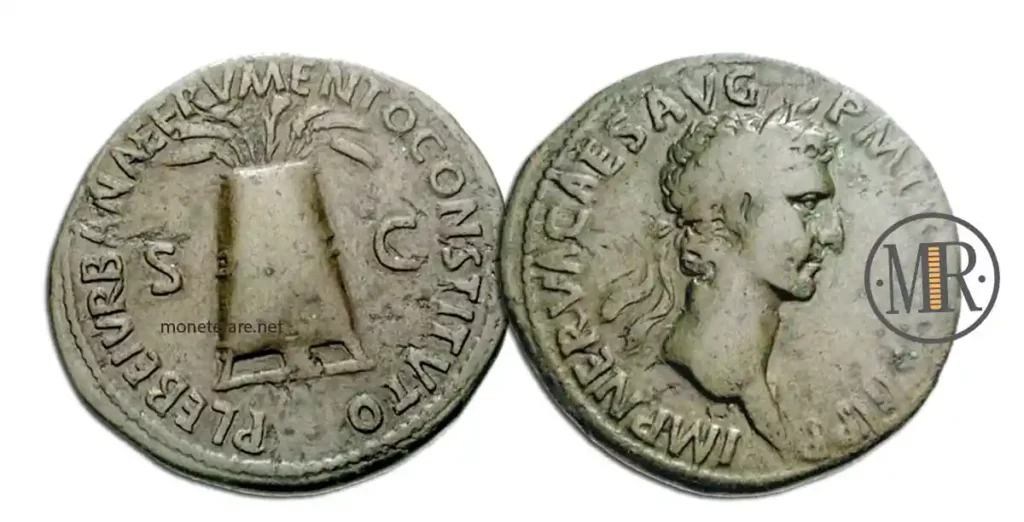
Another type features on the reverse two mules grazing, with a cart and pole in the background.
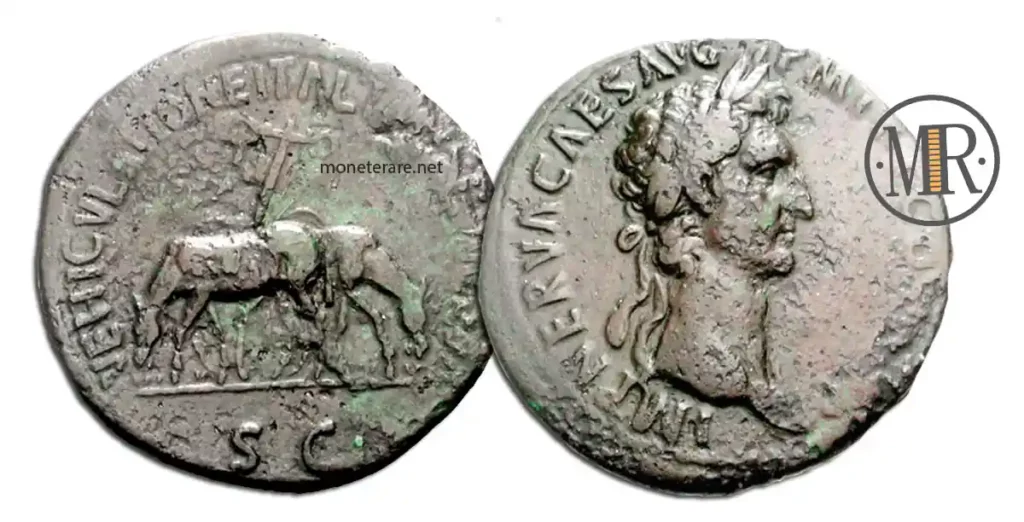
History and Curiosities
Nerva was the first of the so-called “Adoptive Emperors” and introduced the “adoptive principate”, where the Emperor was required to choose his successor from within the Senate.
Nerva adopted General Marcus Ulpius Traianus, granting him the title of Caesar Germanicus following a significant military victory in Pannonia.
Value of the Roman Sesterce of Nerva
- Nerva Sesterces have variable values like all coins. One, classified as BB, was sold at an online auction for €140.
If you own rare coins like these (or even other rarer coins), you can have fun and make money by auctioning them online. We always use this partner site to buy and sell coins at auction. It’s the largest online coin auction platform, and we highly recommend it. Auctioning coins, whether selling or buying, is easy and exciting
Trajan Sesterce
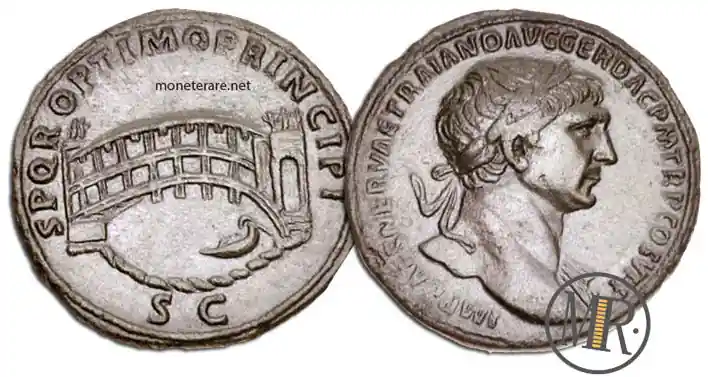
Description
Numerous Sesterces are known to have been minted for Emperor Trajan, with at least 16 different types created for various occasions.
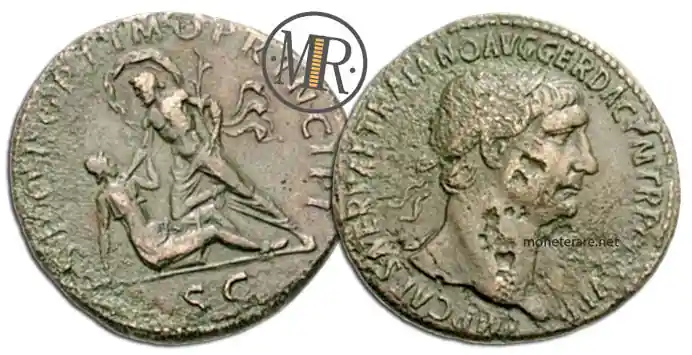
The first ones were minted following the conquest of Dacia. Notable examples include the Sesterce featuring an arched bridge on the reverse, and another with the Tiber subduing and overpowering Dacia.
During the invasion of the Parthian kingdom, Sesterces were minted to commemorate these eastern campaigns.
On the reverse of one of these coins, Trajan is depicted standing with a sword and spear, with figures of the Tigris, Euphrates, and Armenia at his feet.
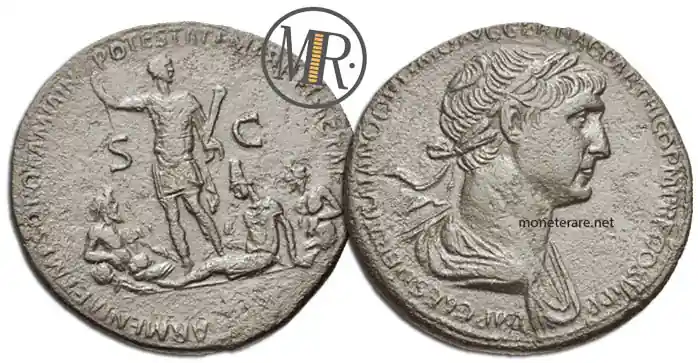
Many Sesterces were minted following the completion of public works projects.
- A Sesterce minted to mark the construction of the new “Portum Traiani” was auctioned in 2017 for €12,000!
History and Curiosities
Under Trajan’s leadership, the Roman Empire reached its greatest territorial extent, thanks to the conquests of Armenia, Mesopotamia, Assyria, Dacia, and others.
Trajan is considered one of the best Roman Emperors and was the only one to govern without any contestation.
Value of the Roman Sesterce of Trajan
- Trajan Sesterces are commonly found for sale at auctions, with prices varying based on rarity and condition, starting at around €70.
- An interesting auction result is for a Trajan Sesterce in BB+ condition featuring Trajan seated with three men saluting him in the foreground, sold for €800 on October 21, 2018.
Marcus Aurelius Sesterce
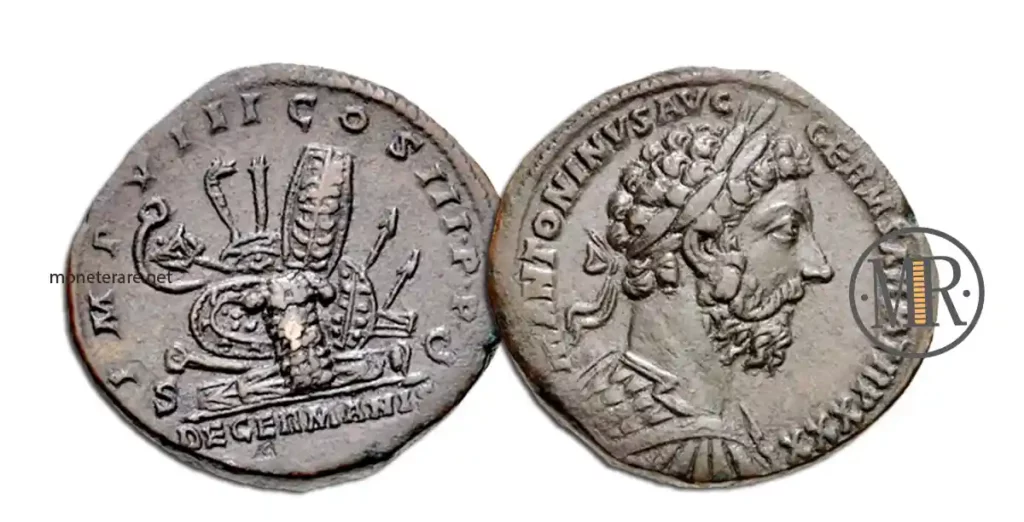
Description
On the obverse of many Sesterces minted during the co-regency of Marcus Aurelius and Lucius Verus, appears the profile of one or the other emperor, while the reverse serves as a variable and effective means of propaganda.
In a Sesterce minted in 161 AD to mark their accession to power, the obverse features the bust of Lucius Verus, while the reverse depicts Lucius and Marcus Aurelius standing, facing each other, shaking hands.
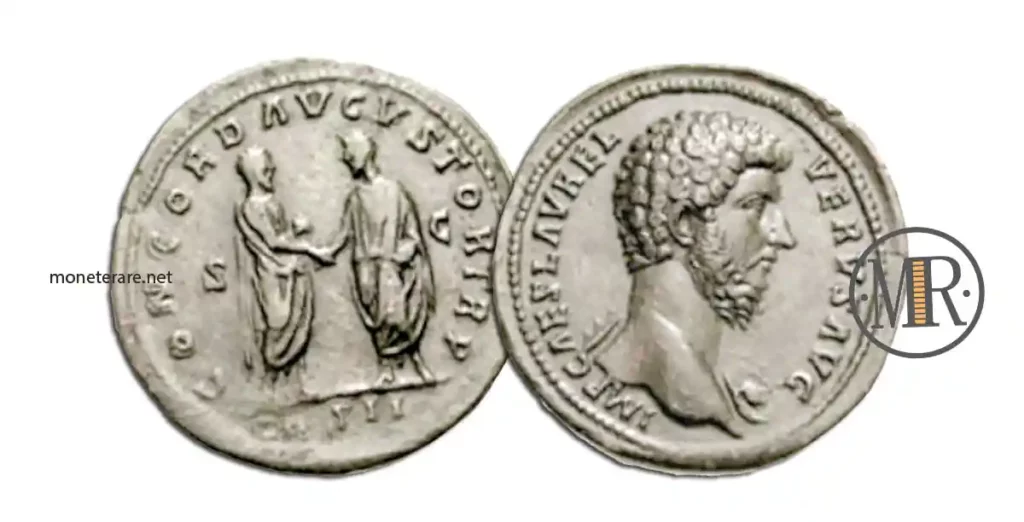
Another example of a Marcus Aurelius Sesterce, with his bust on the obverse, was minted in 177 AD following the victory over the Germans, with the reverse depicting a pile of weapons of the subdued Germans.
History and Curiosities
Marcus Aurelius was the first Emperor to rule not alone but by sharing power with his adoptive brother, Lucius Verus.
Both were adopted by Emperor Hadrian, and when Marcus Aurelius was chosen by the Senate to become Emperor, he insisted that Lucius Verus also be appointed Emperor alongside him.
Nonetheless, Marcus Aurelius held greater authority compared to Lucius Verus.
Value of the Roman Sesterce of Marcus Aurelius
Maximinus Thrax Sesterce
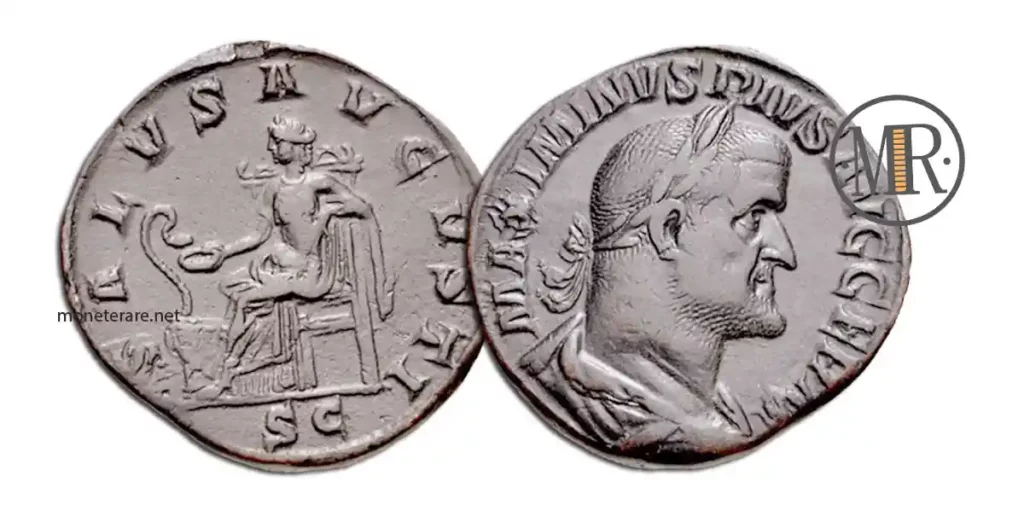
Description
On the obverse of Sesterces minted during the reign of Maximinus Thrax, his bust is depicted. The reverse of these Sesterces, minted after 236 AD following victories in Germany, features various scenes.
One type of Sesterce, “VICTORIA GERMANICA,” shows a winged Victory with a prisoner at her feet. Another, “SALVS AVGVSTI,” depicts the goddess Salus holding a bowl from which a serpent feeds. On other Sesterces, Maximinus is shown standing between two legionary standards.
History and Curiosities
Maximinus Thrax was the first Emperor of barbarian origin.
Interestingly, despite his name, “Maximinus,” he was one of the tallest men in human history, standing between 239 and 248 centimeters tall!
Value of the Roman Sesterce of Maximinus Thrax
- Sesterces of Maximinus Thrax are available online starting at around €50.
Gordian Sesterce
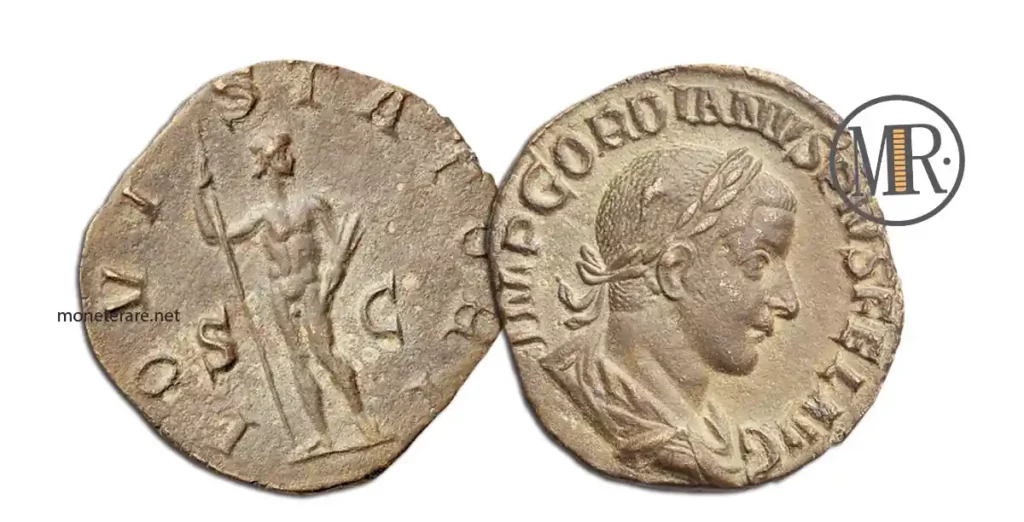
Description
On the Sesterces minted by the first two Gordians, the obverse features the profile of Gordian I, while the reverse shows a winged Victory or Virtus holding a shield and spear.
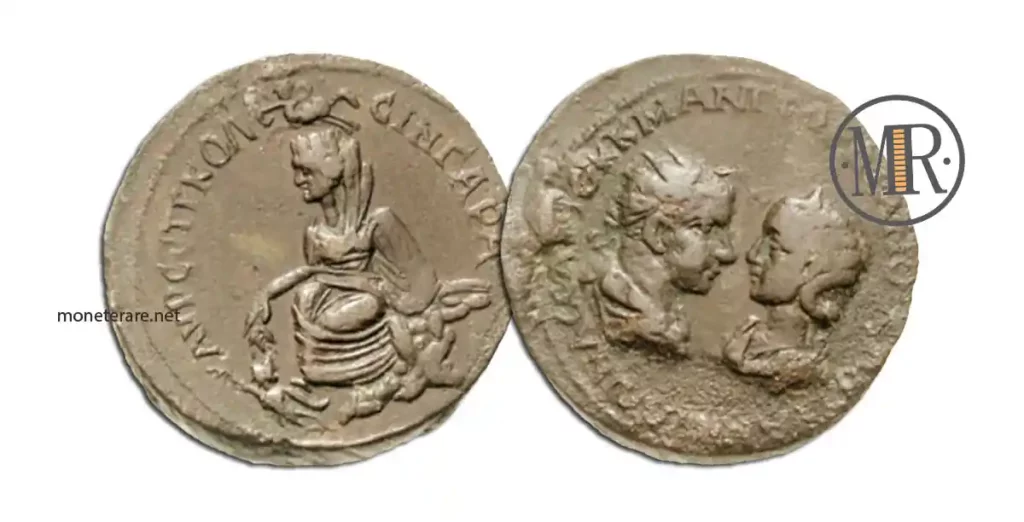
On the Sesterces of Gordian III, except for one instance where he is depicted alongside his wife Tranquillina, his bust always appears on the obverse.
On the Sesterce of Gordian III and his wife, the reverse shows Tyche, the personification of fortune, holding a small boat, with a small Sagittarius symbol representing the Legio I Parthica above.
On other Sesterces of Gordian III, depictions include Gordian himself, a winged Victory, or Mars with a shield and spear.
History and Curiosities
There were three Emperors named Gordian, successors to Maximinus Thrax. The first two, Gordian I and his son Gordian II, were proclaimed by the people of the province of Africa following the revolts of 238 AD. They ruled for only a few weeks. Gordian III, grandson of Gordian I, ascended to the imperial throne at a young age and ruled from 238 to 244 AD.
Value of the Roman Sesterce of Gordian
- A Gordian III Sesterce with Apollo on the reverse, in qSPL condition, is available for approximately €80.
Frequently Asked Questions about Roman Sesterces
- How many sesterces was a denarius worth?
A denarius was equivalent to 4 sesterces. - What is a Vespasian Sesterce worth?
It’s impossible to provide a precise evaluation; it depends on the type, quality, and condition. It can range from a few hundred euros to tens of thousands of euros (see the chapter above).

